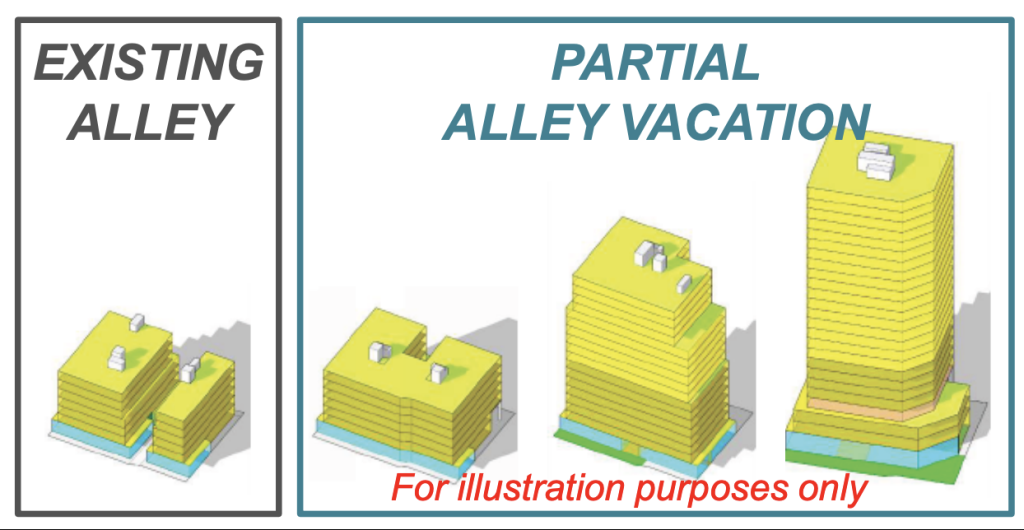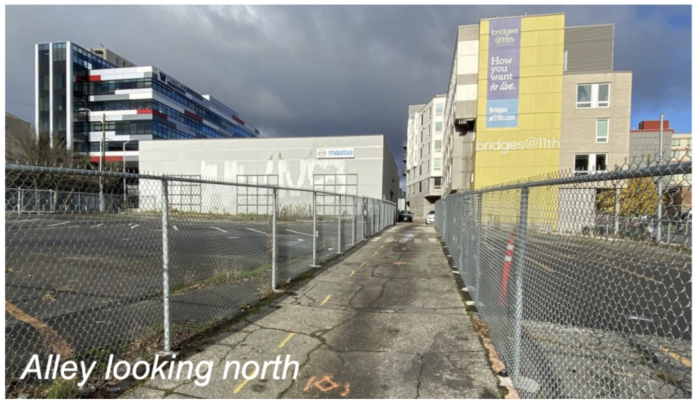In the University District, Sound Transit is moving ahead with planning equitable transit-oriented development on surplus property. The agency owns two parcels of land (about 18,000 square feet) on the north side of NE 45th Street between Roosevelt Way NE and 12th Avenue NE. The parcels are separated by a narrow alleyway and the agency is seeking vacation of it to do a much larger housing project. That’s consistent with public feedback on site development priorities, which indicated strong support for maximizing affordable housing development.
When U District Station was under construction, the properties were being used a construction staging site since it was a mostly surface parking lot prior to Sound Transit ownership and within two blocks of the station site. In the interim, the properties are being used as a temporary tiny house village

Zoning on the property allows for various development approaches ranging from lowrise to highrise construction. Sound Transit could pursue a highrise tower over 320 feet, if desired, but the agency did note that the approach has some challenges. The alley, as it is, limits tower placement, other development nearby further affects setbacks, and highrise development can be more expensive requiring higher levels of subsidy in affordable housing development. Without an alley vacation, midrise construction in the six- to eight-story range may be more optimal and net about 77 homes. If an alley vacation were approved, the agency believes that highrise construction would be much easier to to do and could deliver more than 200 homes.
To provide the most amount of flexibility, Sound Transit has started the alley vacation request process. There is no guarantee it will be approved, but if permitted there will likely be certain conditions to address access given that the alley fully exists today with pavement. But unlike private for-profit parties, transfer of real estate from the alley vacation could be done for free since it would be for affordable housing project.
In terms of development priorities, Sound Transit wants to maximize the number of homes developed with all being affordable to households making 80% or less of the area median income (ideally even lower at 60% or less), create active ground-floor uses for commercial and community spaces, and deliver a healthy streetscape that is wide for pedestrians and includes street trees and landscaping features.
For now, the properties will continue to be used as a tiny house village, which is sponsored by the King County Regional Homelessness Authority and operated by the Low Income Housing Institute. A total of 36 furnished tiny houses are spread across the properties with security and services. Under agreement terms, Sound Transit is leasing the properties for this purpose annually with potential extensions to 2024.
How long the development and permitting process will take remains to be seen, but it will certainly extend well beyond 2024 since a developer and particular design approach haven’t even been chosen yet. A solicitation process for affordable housing developers to bid on a project is expected to begin in the second quarter of 2023. Following that, a specific development proposal to be approved by the Sound Transit board is expected to come sometime in 2024, though it would still need to gain separate approval from the City of Seattle.
Stephen is a professional urban planner in Puget Sound with a passion for sustainable, livable, and diverse cities. He is especially interested in how policies, regulations, and programs can promote positive outcomes for communities. With stints in great cities like Bellingham and Cork, Stephen currently lives in Seattle. He primarily covers land use and transportation issues and has been with The Urbanist since 2014.


